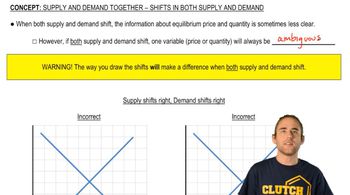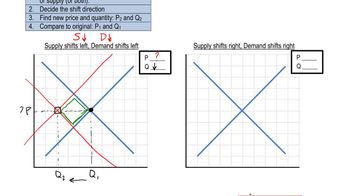Table of contents
- 1. Introduction to Macroeconomics
- 2. Introductory Economic Models
- 3. Supply and Demand
- Introduction to Supply and Demand
- The Basics of Demand
- Individual Demand and Market Demand
- Shifting Demand
- The Basics of Supply
- Individual Supply and Market Supply
- Shifting Supply
- Big Daddy Shift Summary
- Supply and Demand Together: Equilibrium, Shortage, and Surplus
- Supply and Demand Together: One-sided Shifts
- Supply and Demand Together: Both Shift
- Supply and Demand: Quantitative Analysis
- 4. Elasticity
- Percentage Change and Price Elasticity of Demand
- Elasticity and the Midpoint Method
- Price Elasticity of Demand on a Graph
- Determinants of Price Elasticity of Demand
- Total Revenue Test
- Total Revenue Along a Linear Demand Curve
- Income Elasticity of Demand
- Cross-Price Elasticity of Demand
- Price Elasticity of Supply
- Price Elasticity of Supply on a Graph
- Elasticity Summary
- 5. Consumer and Producer Surplus; Price Ceilings and Price Floors
- Consumer Surplus and WIllingness to Pay
- Producer Surplus and Willingness to Sell
- Economic Surplus and Efficiency
- Quantitative Analysis of Consumer and Producer Surplus at Equilibrium
- Price Ceilings, Price Floors, and Black Markets
- Quantitative Analysis of Price Ceilings and Floors: Finding Points
- Quantitative Analysis of Price Ceilings and Floors: Finding Areas
- 6. Introduction to Taxes
- 7. Externalities
- 8. The Types of Goods
- 9. International Trade
- 10. Introducing Economic Concepts
- Introducing Concepts - Business Cycle
- Introducing Concepts - Nominal GDP and Real GDP
- Introducing Concepts - Unemployment and Inflation
- Introducing Concepts - Economic Growth
- Introducing Concepts - Savings and Investment
- Introducing Concepts - Trade Deficit and Surplus
- Introducing Concepts - Monetary Policy and Fiscal Policy
- 11. Gross Domestic Product (GDP) and Consumer Price Index (CPI)
- Calculating GDP
- Detailed Explanation of GDP Components
- Value Added Method for Measuring GDP
- Nominal GDP and Real GDP
- Shortcomings of GDP
- Calculating GDP Using the Income Approach
- Other Measures of Total Production and Total Income
- Consumer Price Index (CPI)
- Using CPI to Adjust for Inflation
- Problems with the Consumer Price Index (CPI)
- 12. Unemployment and Inflation
- Labor Force and Unemployment
- Types of Unemployment
- Labor Unions and Collective Bargaining
- Unemployment: Minimum Wage Laws and Efficiency Wages
- Unemployment Trends
- Nominal Interest, Real Interest, and the Fisher Equation
- Nominal Income and Real Income
- Who is Affected by Inflation?
- Demand-Pull and Cost-Push Inflation
- Costs of Inflation: Shoe-leather Costs and Menu Costs
- 13. Productivity and Economic Growth
- 14. The Financial System
- 15. Income and Consumption
- 16. Deriving the Aggregate Expenditures Model
- 17. Aggregate Demand and Aggregate Supply Analysis
- 18. The Monetary System
- 19. Monetary Policy
- 20. Fiscal Policy
- 21. Revisiting Inflation, Unemployment, and Policy
- 22. Balance of Payments
- 23. Exchange Rates
- 24. Macroeconomic Schools of Thought
- 25. Dynamic AD/AS Model
- 26. Special Topics
3. Supply and Demand
Supply and Demand Together: Both Shift
3. Supply and Demand
Supply and Demand Together: Both Shift
Practice this topic
- Multiple Choice
What happens in the market for cream cheese if (1) the price of butter, a substitute for cream cheese, falls and (2) the cost of milk, an input in cream cheese production, rises?
285views - Multiple Choice
If the wages of bus drivers increases at the same time that the income of consumers decrease, what happens in the market for bus rides (assuming that bus rides are an inferior good)?
294views1rank - Multiple Choice
If producers of garden hoses have discovered new technology to improve production, while the number of gardeners increases, what happens in the market for garden hoses?
266views - Multiple Choice
What happens in the market for tennis balls if (1) the price of tennis rackets, a complement for tennis balls, increases and (2) the price of baseballs, a substitute in production, decreases?
457views2rank


